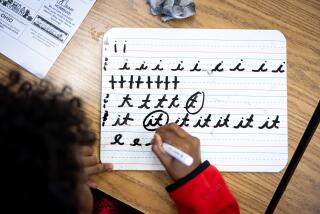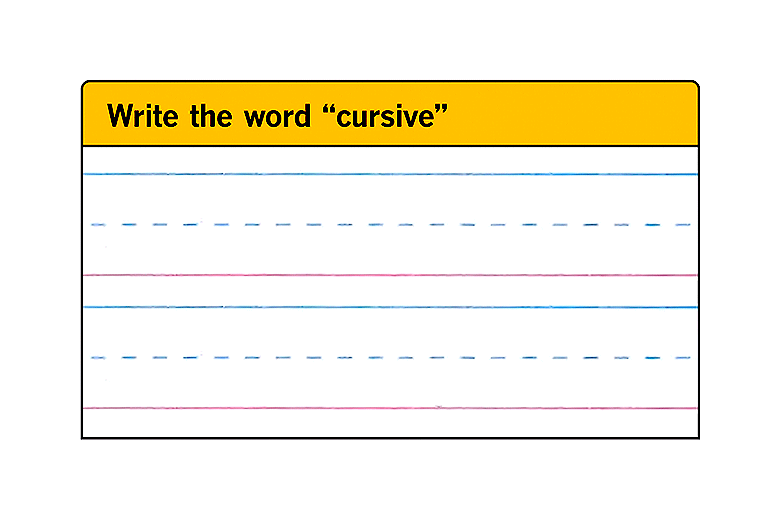In This High-Tech Age, Do Kids Still Need to Dot I’s, Cross Ts?
- Share via
A small loop, a line to the right, a gentle curve, then another line. The third-graders in Geri Nesbitt’s class at Kerrydale Elementary in Prince William County, Va., are practicing the cursive letter V.
While some students go up to an overhead projector to show off their Vs with a purple marker, others sit at their desks, writing “Vera Violet is very vain.”
“I like it because it looks nice,” said Anum Hussain, 8, who said the capital F is her favorite cursive letter.
But at another Prince William school, Pattie Elementary, there are no such drills for third-graders this late in the school year. Their lessons in cursive writing are over by Christmas. And while Kerrydale’s third-graders are required to compose many of their assignments by hand, both at school and at home, those at Pattie are encouraged to do their writing on a computer.
Pattie’s principal, William Huber, says cursive is low on his list of educational priorities.
“Society doesn’t demand it,” he explains.
Is it quaint to learn good penmanship in today’s high-tech age? From one elementary school to the next, you’ll get different answers. Some educators worry that early exposure to key-boarding will produce a generation that can’t scrawl a legible note. Others say that it hardly matters--and that it’s more important for youngsters to type in Web addresses than to practice their loops and ovals.
“It’s a false thought about the computer age, that we won’t need handwriting,” says Jan Z. Olsen, creator of a method of cursive instruction known as “Handwriting Without Tears.” Olsen bemoans the lack of attention paid to students’ penmanship at many schools. “They don’t teach the teachers how to teach the children,” she says.
The pencil and the keyboard are competing tools for children just learning how to express themselves in writing, to a degree that wasn’t true in the era of the typewriter.
Handwriting instruction begins in kindergarten with block letters, but it is usually not until third grade, when children have developed the necessary muscle coordination, that formal lessons and drills begin. By then, many children already have been typing away on their home PCs; some had key-boarding lessons in second grade. The more comfortable they are with typing, the less inclined they are to try to master script.
Debbie Gaiser, whose daughter, Alyson, is a fourth-grader at Pattie, worries that Alyson’s window of opportunity to learn handwriting already has closed. “I don’t think Alyson has written a whole paragraph in cursive,” Gaiser said. “I think she’s still having problems with the mechanics of writing.”
Handwriting instruction reached its peak 90 years ago, according to Tamara Plakins Thornton, a cultural historian and author of the book “Handwriting in America.” At that time, the popular “Palmer method” required students to push and pull their pens across the page before moving up to actual letters and words. It was considered a form of motor learning not so different from athletics--some handwriting teachers had their pupils do calisthenics--and the mark of a well-trained body and mind.
The emphasis on formal drills gradually declined as handwriting came to be seen as simply a tool of communication rather than a separate discipline. In the 1970s, the lessons came under attack from advocates of the “whole language” method, who said that harping on the way students form their letters stifles self-expression.
Many researchers have since rejected that argument, saying that mastering the mechanics of handwriting tends to unleash rather than block creativity.
“If you’re really slow at this, your hand can’t keep up with your thoughts,” said Steven Graham, a professor of special education at the University of Maryland. For young children, those thoughts are hard to recover, Graham said. “The processes of handwriting and spelling are so attention-demanding for very young kids, something has to give.”
In theory, children can grow into creative, self-assured writers while producing all their words on a keyboard and never touching a pen or pencil, Graham said. But because some children still lack access to computers, schools need to continue to stress handwriting instruction, he said.
More to Read
Sign up for Essential California
The most important California stories and recommendations in your inbox every morning.
You may occasionally receive promotional content from the Los Angeles Times.













